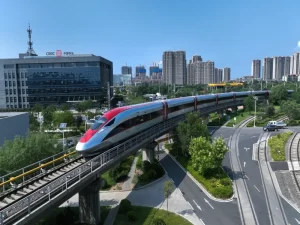The Paris Agreement strives to keep global warming far below 2 degrees[1]. However, UNEP estimates that if net-zero commitments are fully implemented, the world will experience at least a 2.2°C rise in global temperature[2]. These findings show that the trend is currently far exceeding the goal outlined in the Paris Agreement.
Even though climate change is unavoidable, there is still time to halt the tide. Fundamental changes in how we produce food, use land, transport goods, and run our economies will be necessary to achieve this. As a result, it is more important than ever to put fresh, compelling ideas into practice in order to reduce net emissions and green the planet.
Green development is one of those novel practices. Green development means incorporating and integrating energy efficiency, preserving ecosystems, encouraging community cohesion, and reducing reliance onautomobiles3]. There is no such thing as the ideal green development, but current initiatives demonstrate how integrated green development components benefit both society and the environment.
The Belt and Road Initiative (BRI) aims to enhance economic growth and interregional connectivity. BRI has some actions and implementations that align with the Paris Agreement’s net-zero emissions goal by advancing low-carbon infrastructure and technologies. Then how much further could BRI contribute to a greener development?
The presence of BRI may stimulate the development of new innovations and technology that can aid in the transition to a low-carbon economy and infrastructure. Electric vehicles (EVs) are the solution for phase-out fossil fuel power needed to achieve zero emissions. The BRI’s rail project is exemplifies electrified infrastructure. Regarding energy efficiency and carbon emissions, rail transport is second only to shipping in terms of moving people and goods. Supply chains, sustainable manufacturing methods, and d sustainable mobility practices can all benefit from electrified rail projects[4]. Southeast Asia, South Asia, and Africa are all currently developing rail projects.
The Jakarta-Bandung High-Speed Railway in Indonesia is one of Southeast Asia’s rail projects. Indonesia’s capital city will be linked to Bandung by the high-speed railway. The high-speed railway will connect Jakarta’s capital city with Bandung. The railway line’s trial operations are scheduled to begin in November 2022, with full operations starting in June 2023.
The Jakarta-Bandung High-Speed Railway Project is essential to the Belt and Road Initiative. The project is expected to have a positive economic impact for both cities as well as urban and rural areas along the route. Stations and surrounding areas will see increased economic activity and development, including new opportunities in the real estate sector. Beyond that, the project aims to improve distribution in the logistics, manufacturing, services, and power generation industries, which can have a positive impact other sectors and aspects.
As a result, a favourable enabling environment is required to support these efforts. This environment should include effective national and regional policies on climate change and green finance policies, as well as sector-specific legal and regulatory frameworks in energy, transportation, and land use, among other relevant sectors. In fact, local governments can do their part to promote green development through BRI by doing the following:
- Encourage collaboration among various agencies to implement green development.
- Enhance local and international partnerships.
- Establish clear regulatory accountability for emerging and new industries.
- By working together across agencies, consider related or competing regulatory factors, such as land use and allocation for the construction of low-carbon infrastructure.
About the writer:
Galuh Pasha Balqis Ramadhanty, Bachelor in Urban and regional planning, Sepuluh Nopember Institute of Technology and knowledge Management Intern at the UCLG ASPAC Secretariat.
Sources:
- https://unfccc.int/process-and-meetings/the-paris-agreement/the-paris-agreement
- https://www.unep.org/annualreport/2021/index.php
- https://books.google.co.id/books/about/Green_Development.html?id=Gqu5AAAAIAAJ&redir_esc=y
- https://www.iea.org/reports/net-zero-by-2050
- https://www.pwccn.com/en/sustainability-and-climate-change/advancing-green-development-the-br-initiative-jan2022.pdf
- https://unsplash.com/photos/gJhev0YgUcE
